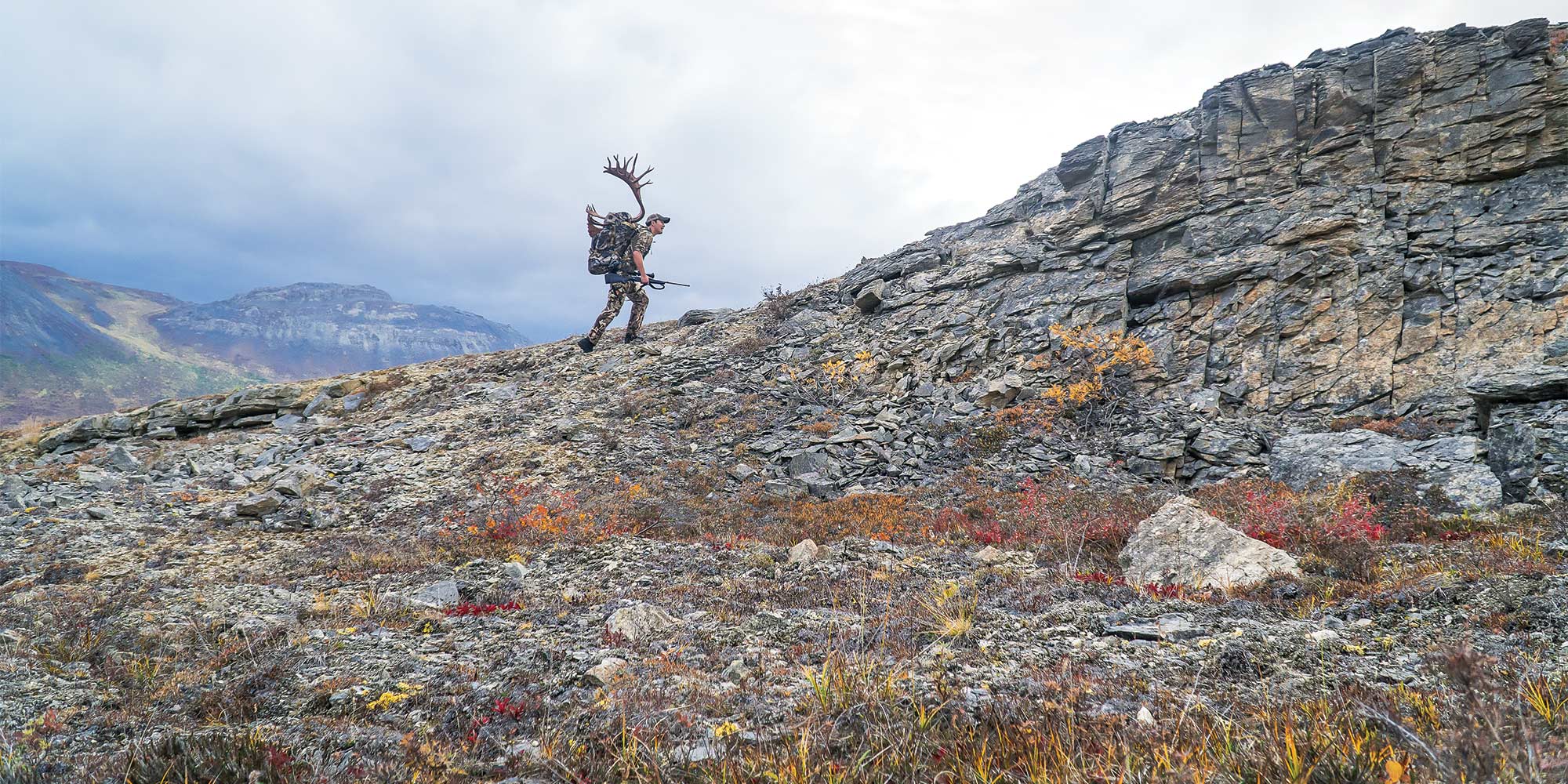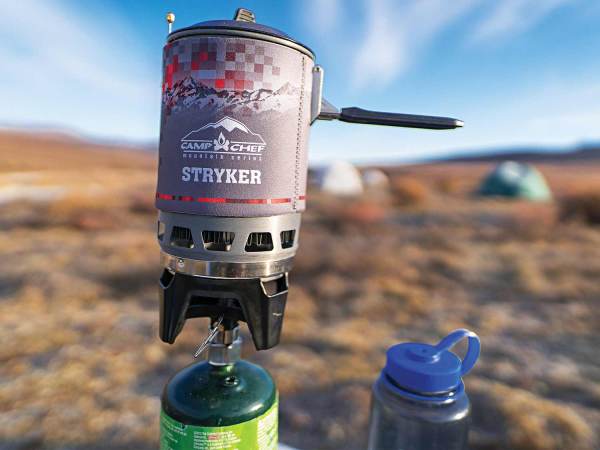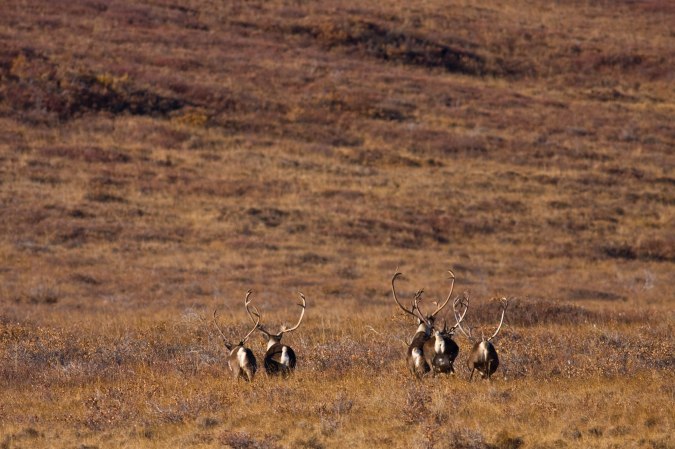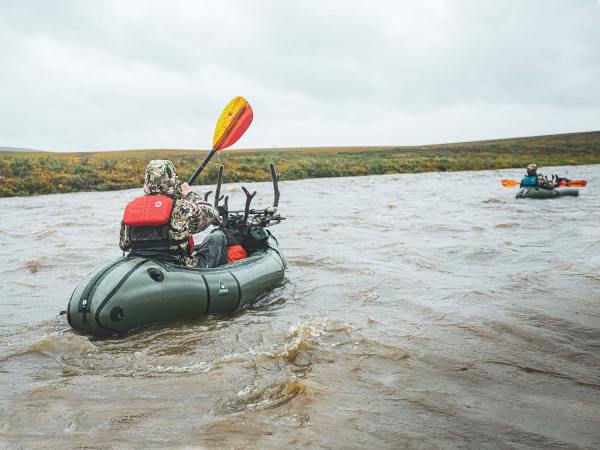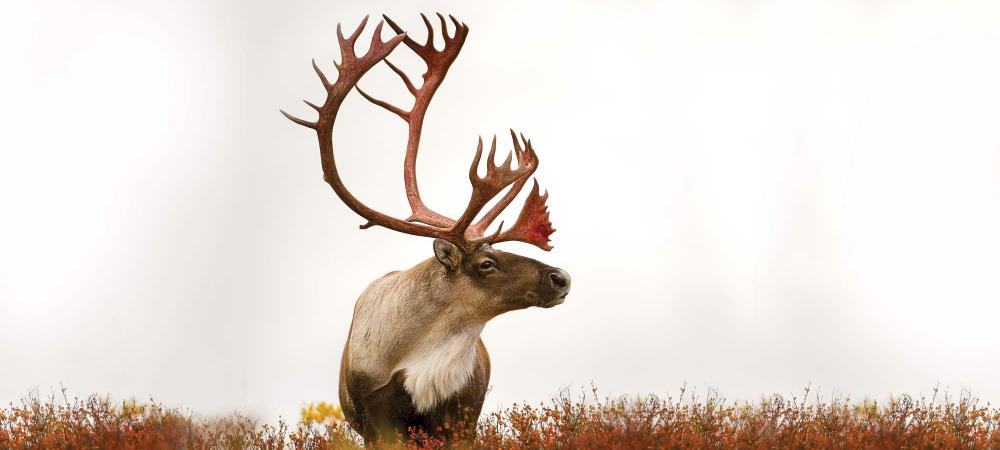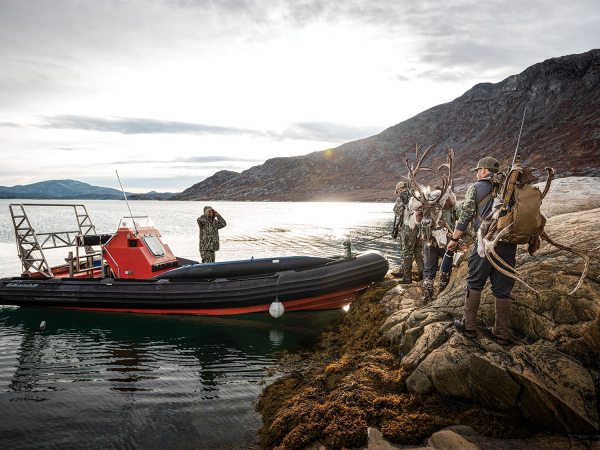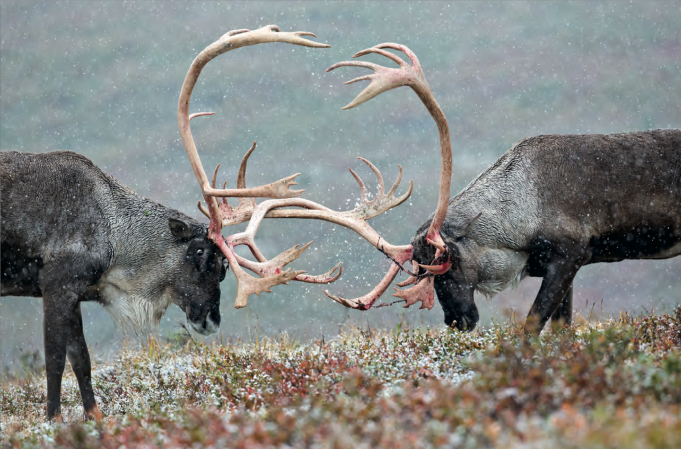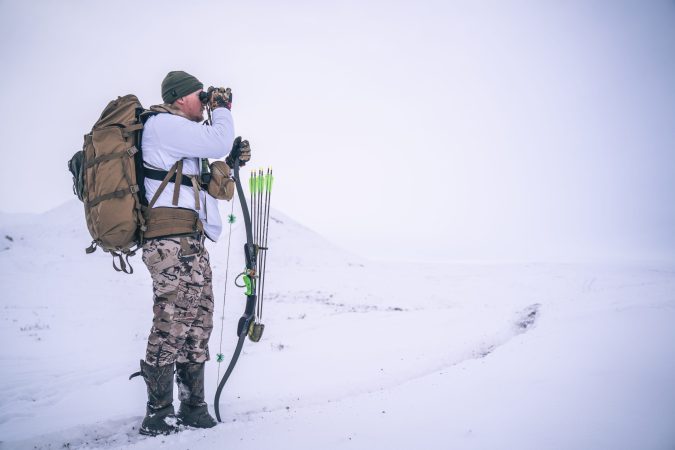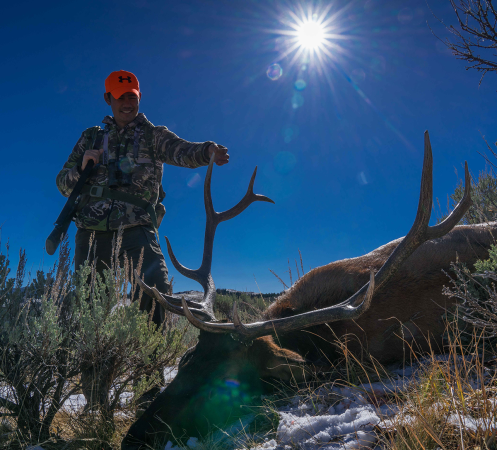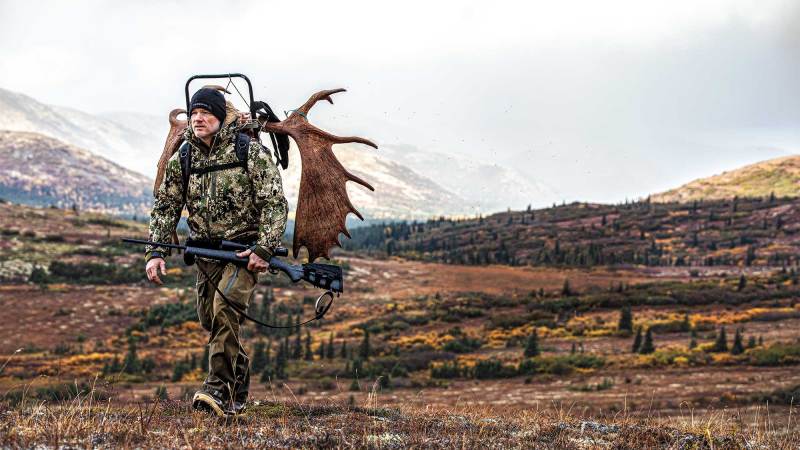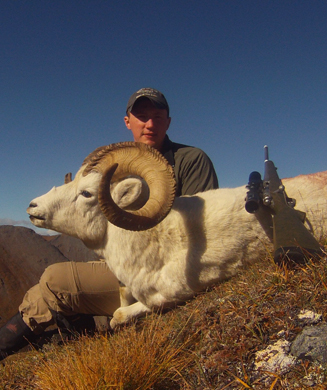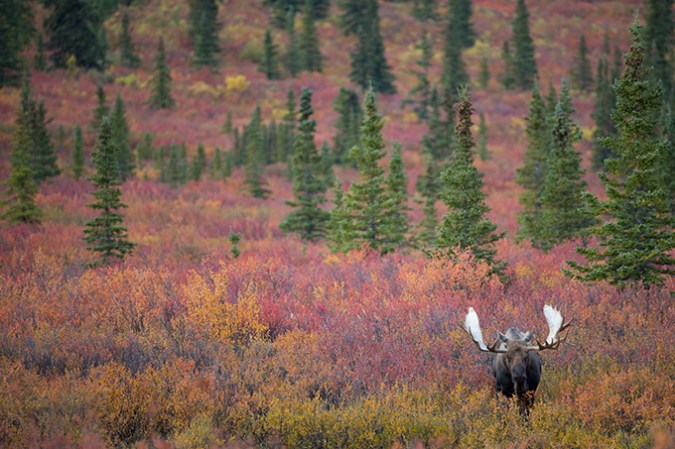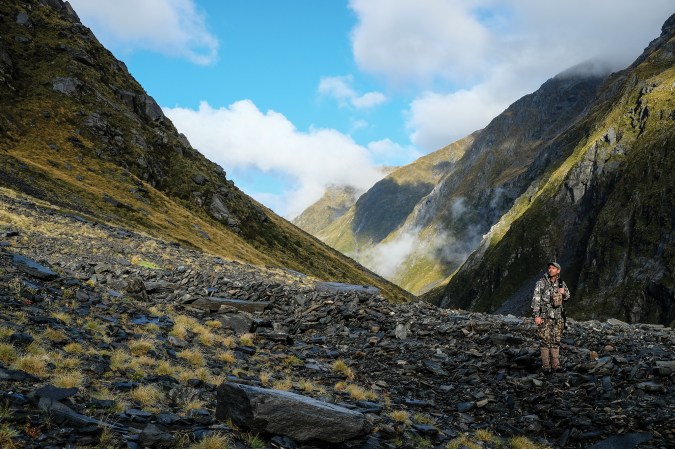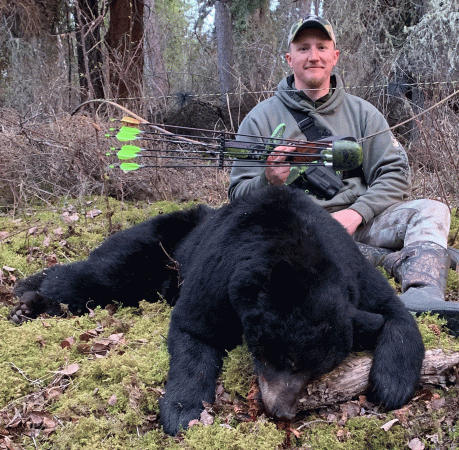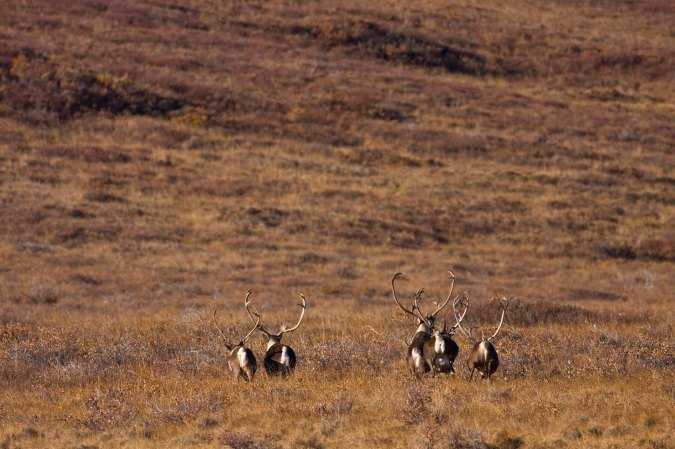He’s a very big bull. That much I can tell, even though he is among the first wild caribou I’ve ever seen. I settle the spotter on him and watch his rack tower over the alders. The bull’s main beams sweep back in a deep C shape, and those C’s are topped with foot-long tines reaching skyward. His mane is long and white, whiter than those of the two younger bulls hanging around him.
He’s the most impressive critter I’ve ever seen, but he’s about a mile away, feeding on the side of a mountain, with daylight starting to fade. Even more important, we had flown into camp earlier in the day, so we’d have to wait until morning before we could legally hunt him or any other bull.
By morning, the old white bull and his two running mates would surely be gone. We were camped almost 100 miles north of the Arctic Circle along a tributary to the Noatak River, which runs out to the Chukchi Sea on Alaska’s northwestern coast. I’d wanted to hunt caribou since watching Saturday-morning hunting shows on ESPN 2 as a little kid. So, when I finally got the opportunity, I did all the research I could on Rangifer tarandus.
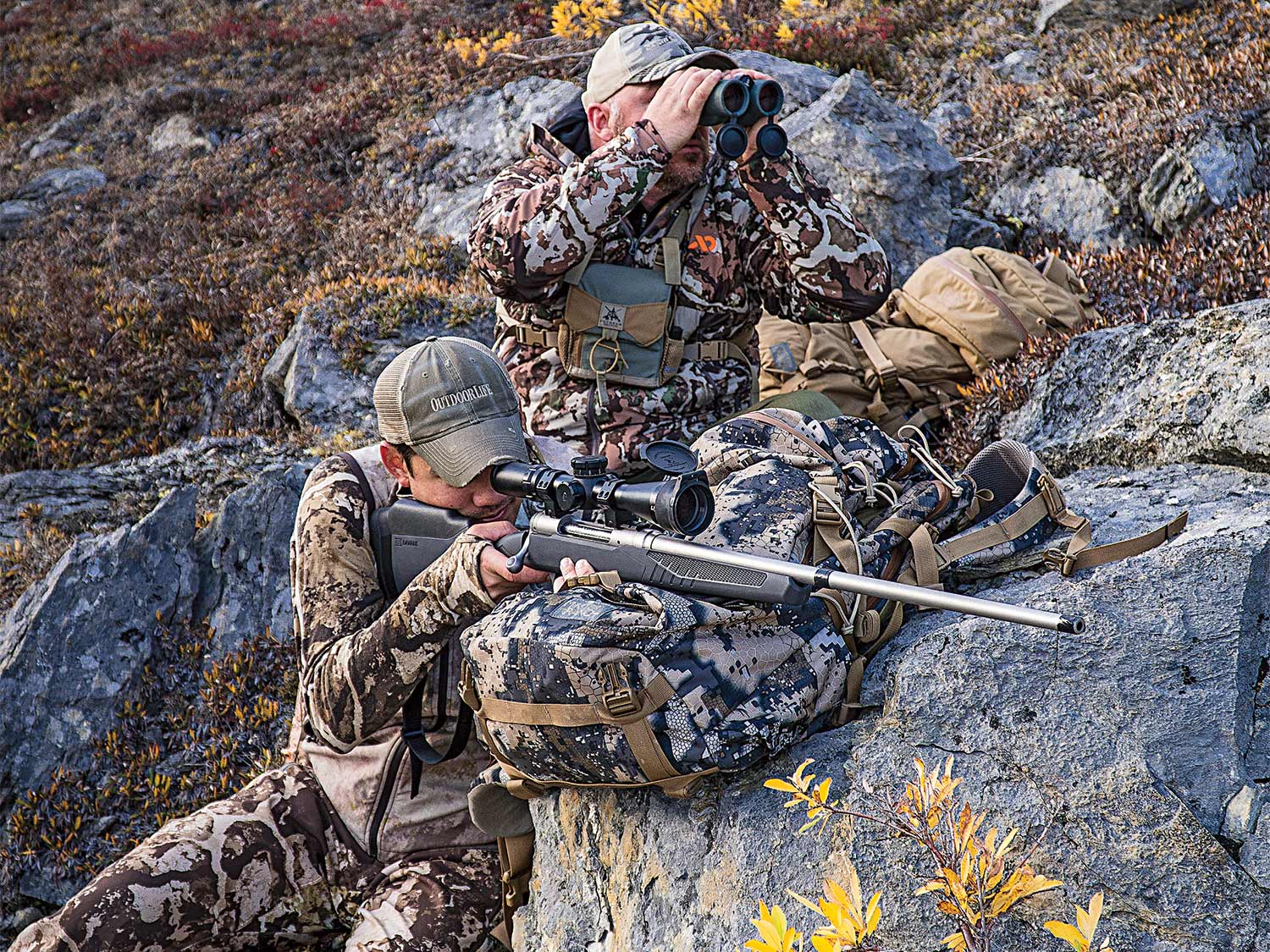
Jack O’Connor, Outdoor Life’s most famous shooting editor, once wrote: “No more beautiful big-game animal than a bull caribou walks the face of the Earth…the very epitome of the wild and uninhabited northland of mountain and glacier and tundra.”
Then he went on to say, “But he is, alas, a dumb and rattle-brained creature.”
The veteran caribou hunters I talked to put it more kindly. These animals are always on the move, often with no clear purpose. A herd of caribou might be feeding contentedly in a valley at one moment, then run full tilt over a ridge the next moment without a predator in sight. The radio-collar studies I perused showed that during late August to mid-September, Alaska caribou have a daily median speed of about 0.5 kilometers per hour, meaning they travel on average about 7 miles per day. If you can count on caribou to do one thing, the veteran hunters told me, it is to keep moving.
So, we pack away our glass for the evening and let the trio of bulls fade into the mountains.
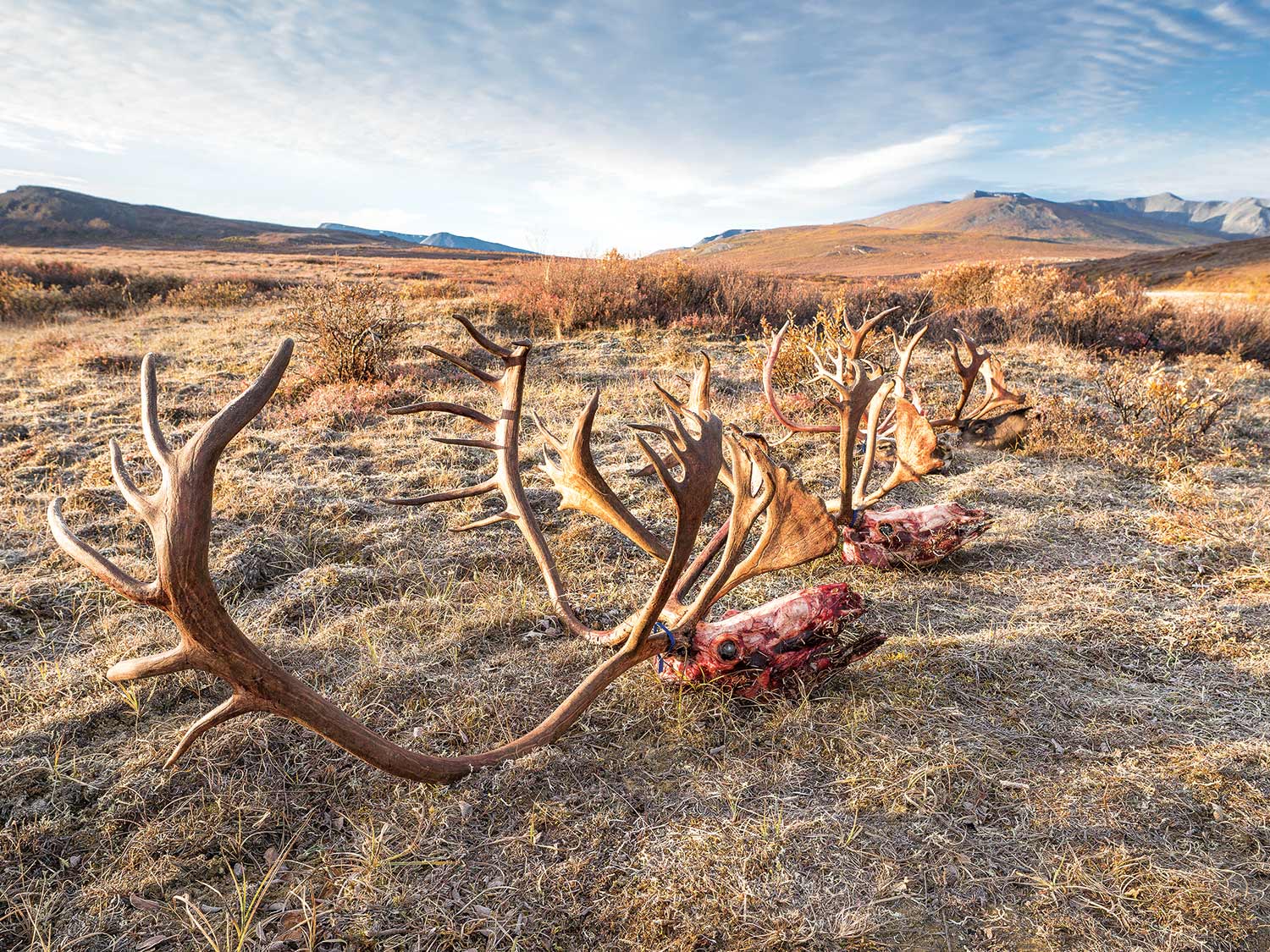
Getting There
My hunting partners—Brooks Hansen, a public-relations rep from Camp Chef, and John Whipple, a photographer from Palmer, Alaska—and I had been dropped off on a river gravel bar with all of our food and gear for the week.
I had flown from Minneapolis to Anchorage, and then to Kotzebue, a mining and fishing town of a little more than 3,000 wind-battered souls. Kotz serves as a supply hub for 10 satellite Inupiat (pronounced In-yu-pak) villages and a main jumping-off point for nonresident caribou hunters. The town’s Chinese restaurant, where most of these visiting hunters end up eating, has a massive mammoth tusk on display that locals found washed up on their beach—they had hauled it up to town on a four wheeler. You don’t have to try too hard to imagine woolly mammoths migrating across the tundra here during the last ice age. Kotzebue’s average high temperature in August is 56 degrees.
From here, we flew in bush planes, one at a time, to the gravel-bar landing strip.
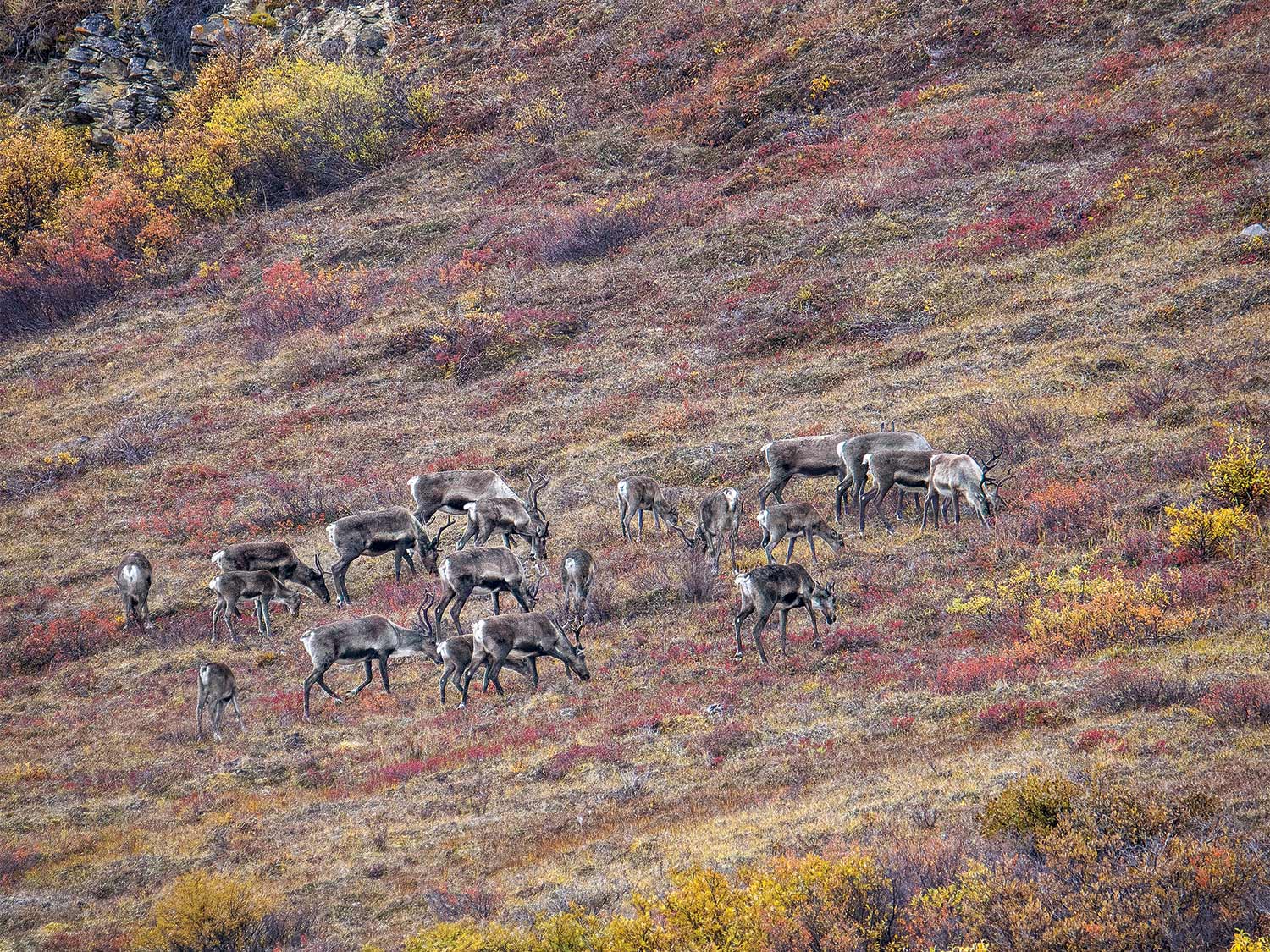
“Good luck, don’t die,” was the last thing our charter pilot said, with only a hint of sarcasm, before slamming the cockpit door and taking off.
Near the strip we found a skinned grizzly carcass, left by the hunters before us. In their old camp, we found two quartered caribou carcasses; apparently, they had killed their bulls without straying far. So we decided to make our camp on the far side of the river and kept our rifles close as we pitched our tents.
Our other two hunting partners were stranded back in Kotzebue. Heavy cloud cover had pushed into the valley and prevented David Draper, the editor of Petersen’s Hunting, and his girlfriend, Tess Rousey, from being able to fly in safely. This is standard operating procedure for many hunts in Alaska, where travel into the backcountry relies on bush planes, and smart pilots don’t fly into the mountains under a low ceiling. So, while we hunkered down for our first night in the camp, Draper and Rousey ate bulgogi and drank beer, not without some bitterness, back in town.
The Mystery Herd
The Western Arctic herd (WAH) is one of the largest caribou herds in the world and the largest in Alaska. It hit its modern-day peak population of almost a half-million animals in 2003 before dropping to about 200,000 in 2012. Hunters and caribou researchers began to stress over these declines as other caribou populations around the world dropped at the same time. Researchers found that the WAH was struggling to recruit calves, says Lincoln Parrett, the Alaska Department of Fish and Game caribou research coordinator who supervises the region. They were seeing fewer calves make it to one year old, which meant the herd was getting older on average, making it more susceptible to harsh winters and predators.
But why the drop in calf recruitment? Parrett and his fellow researchers weren’t quite sure. In recent years, herd numbers started increasing again. Calves that researchers captured for their survival studies were plump and healthy. Parrett theorized that as the population dropped, only the prime animals survived. These surviving caribou are better at recruiting calves, and their offspring would be too.
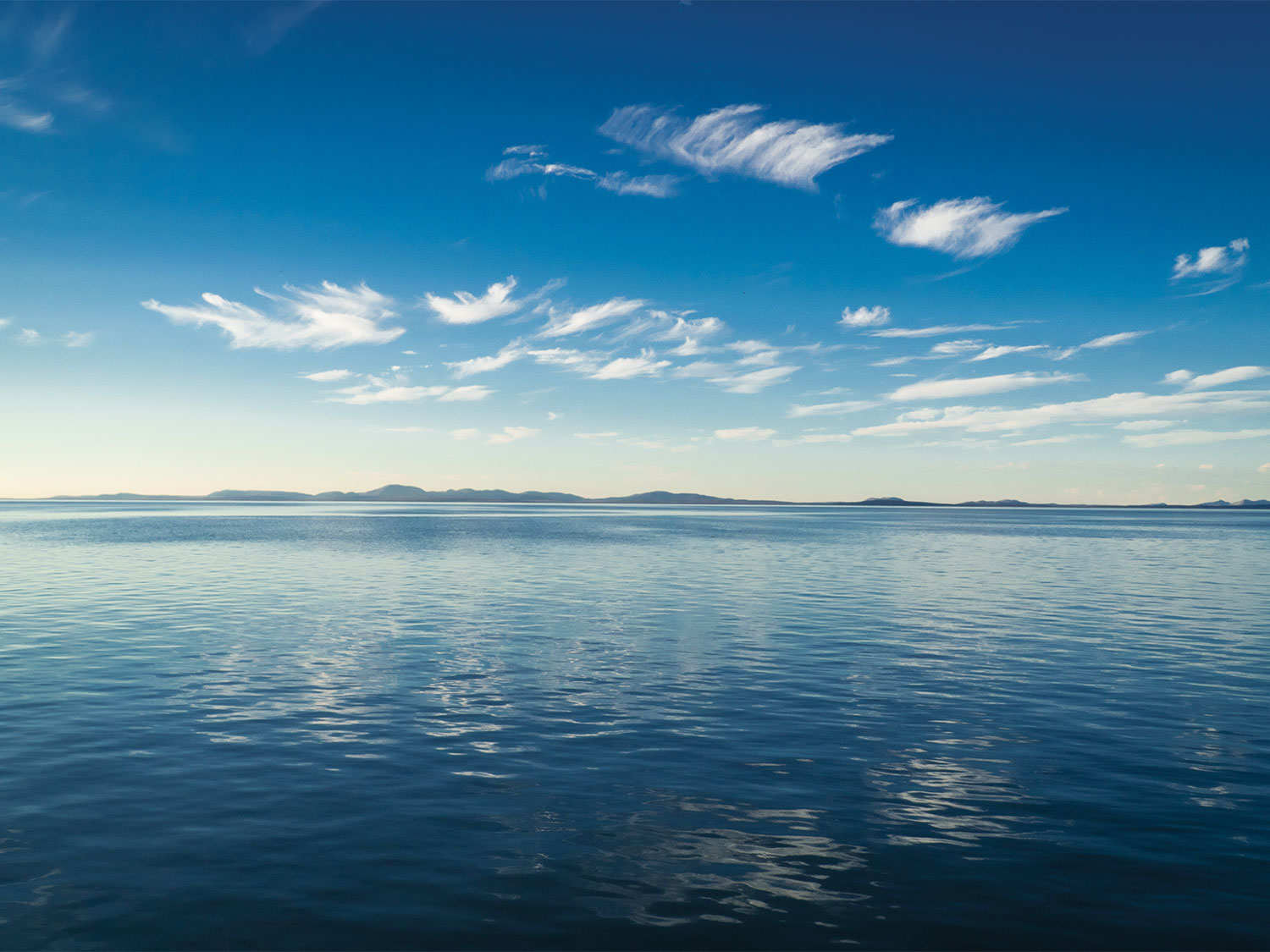
The WAH was estimated at about 230,000 animals—with calf production and survival fairly high—in the summer of 2018, just before we arrived. The herd had declined mysteriously, and now it was rebounding mysteriously.
Our flight into Kotzebue was full of caribou hunters, but Parrett says hunting pressure has relatively no impact on the herd’s overall population. Hunting tradition in this corner of the world is deep—this becomes obvious when you stroll through town and see moose and caribou racks hanging over every door. The Inuit have been hunting caribou in this region for thousands of years, ever since their ancestors migrated across the Bering land bridge.
Modern-day hunters take an estimated 12,000 caribou from the herd each season. About 11,000 of those animals are killed by locals who are out to fill their freezers and feed their families with meat—an Alaska resident can kill five caribou per day in this unit. The rest are tagged by traveling hunters like us, who have come to the Arctic for the adventure, a trophy bull, and the meat that comes with it.
As the caribou migrate from their summering grounds throughout the Brooks Range and south toward the Seward Peninsula, hunters travel up west-flowing rivers to intercept them along the way. But the Western Arctic caribou don’t migrate in one giant herd as you might imagine—a never-ending sea of gray and white hides flowing across a flat tundra. Instead, they’re scattered in groups of about 10 to 30 animals that trickle across the mountain ridges. They hang out in habitat that looks—at least to an uninitiated Lower 48er—more suitable for mountain sheep than caribou. Somehow, these herds manage to locate each other in the mountains and band together before finally gathering en masse around the Kotzebue Sound.
Parrett says the herd’s migration patterns shift slightly every few years, and now more and more caribou are actually migrating to the north slope of the Brooks Range to winter, instead of coming south to the sound. This is frustrating to south-slope hunters who rely on caribou meat to get them through the year—but it’s fascinating for a researcher like Parrett.
“What a spectacle it is for a herd of that size to choose where it wants to go,” he says. “Their ability to find each other and how they respond in unison to large-scale environmental changes, that just blows my mind. It’s one of those things as a scientist, and personally for me, [that] makes me think maybe some things just need to maintain their mystery. Maybe some things don’t need to be explained.”
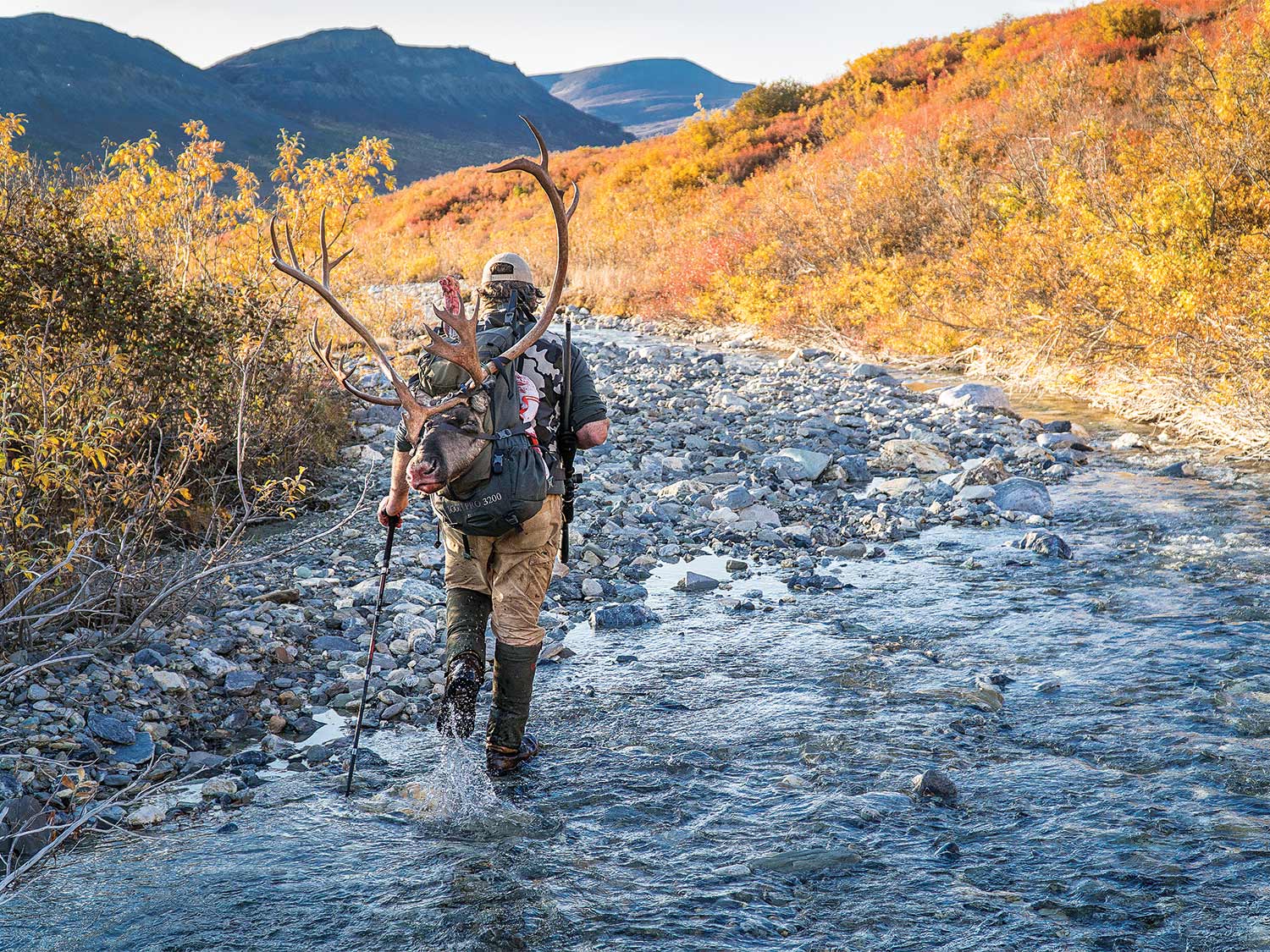
The White Bull
Against all logic, the big bull and his two companions are still on the mountainside in the morning. Through my binoculars, I watch him feed on arctic grasses and lichen while Hansen fries eggs and Whipple organizes camera gear. I estimate the bull is more than a mile away across a muskeg flat and then three-quarters of the way up the low mountain.
I know we should be hustling to close the distance on the bull, but I don’t want to be that guy in camp barking at everyone to hurry the hell up. So, I follow Hansen’s lead. I eat breakfast and drink coffee. We take our time.
The arctic tundra conjures dull images of gray and white desolation. But that’s not what it looks like in late summer. The mountainside is full of early-fall color: bright green and gold willows, blood-red blueberry bushes, and turquoise rivers.
Hiking through the muskeg is slow going. Imagine a grassy marsh with ankle-deep muck, and scattered throughout this marsh are softball- to bowling-ball-size mounds of hard-packed dirt covered in moss. Reaching the solid slope of the mountainside is a relief.
As we pick our way uphill, the three bulls disappear from view, but we keep pushing upward anyway. Every few hundred yards we stop and glass, and ask each other questions that we can’t answer.
“Do you think they’re still up there?”
“I wonder if they slipped into the willows?”
“Maybe they topped out over the ridge?”
And finally, “I bet they bedded down somewhere up there,” Hansen says. And he’s right. Across a draw, some 500 yards away, he spots the big bull bedded with the two smaller animals.
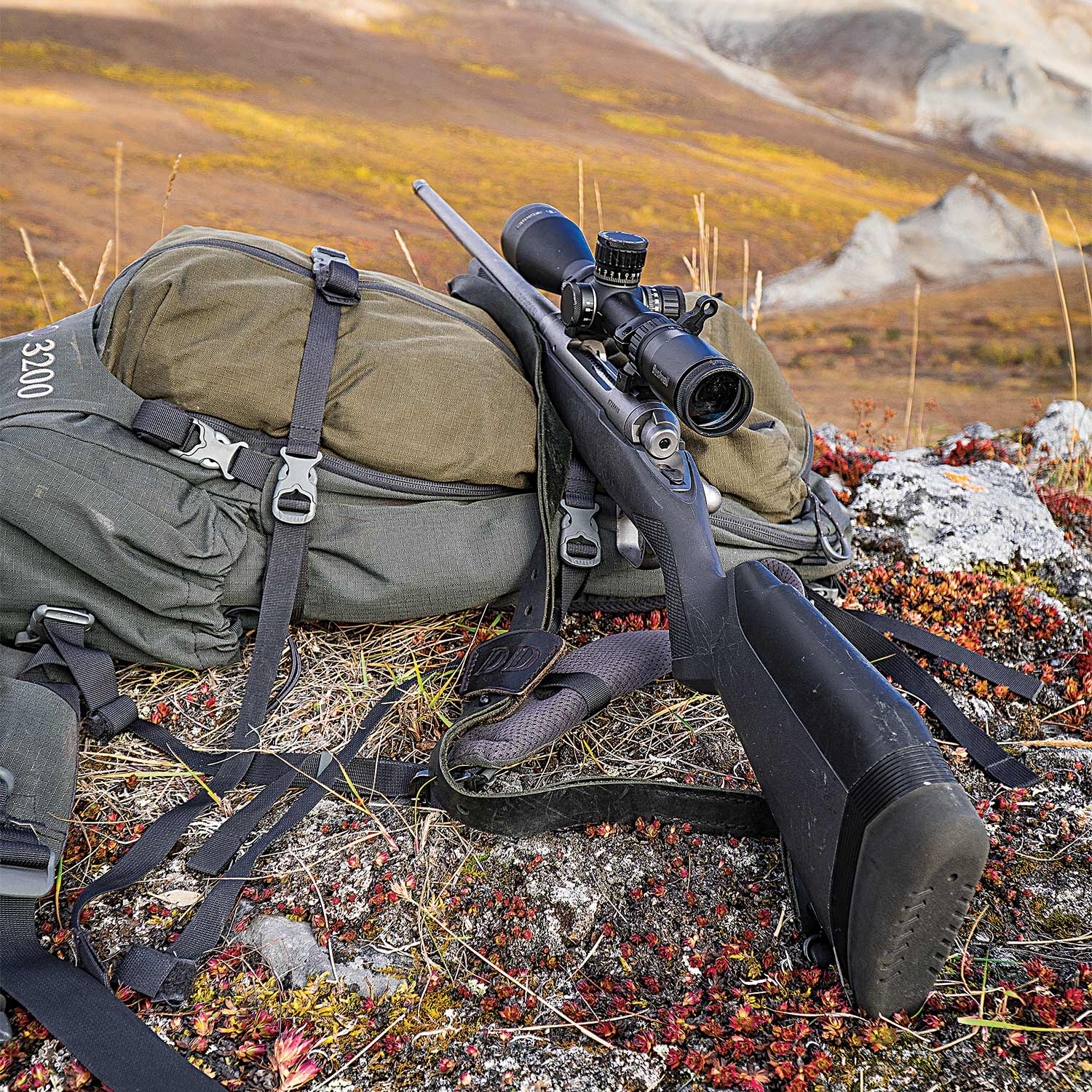
We crawl to within 430 yards of the bulls and then run out of cover. The big white bull is dozing on his side, with the two other caribou about 20 yards away. The second-largest bull has tall antlers that are palmated at the tops. Hansen and I agree that we’ll kill both bulls if we get the chance. But the wind is gusting hard through the draw, and we decide not to risk a long shot. We back out and try to get closer by looping around and climbing above the bulls. But I foolishly take a route that skylines us. No mountain game animal, even the rattle-brained caribou, will tolerate a predator stalking around on the ridge above him.
The bulls break from their beds and start plodding downhill. They are not in a panicked flee just yet, so we change direction and hustle down our side of the draw, hoping to get ahead of them. We must move fast enough that we gain on the bulls, but not so fast that we’re noisily kicking rocks, which will only send the caribou into full escape mode.
We get about halfway down the mountain and nestle into a big rock outcropping to catch our breath and relocate the caribou. Now that we’re out of sight, the bulls have seemingly forgotten about us. They’re still walking the edge of the draw, but they stop to feed and rake brush with their antlers as they go. I watch the white bull closely, this time through the riflescope.
Eventually, he leads the other two bulls to within 300 yards. He turns broadside and stands still for a moment. My rifle booms, and the bull disappears into the willows.
“He’s down,” Whipple says. “Let’s get that other one.”
Brooks slides into my shooting rest while I swap my rifle for binos to spot for him. The other two bulls are running, but not away from us. It seems like they’re unsure of what the shot was and are now looping closer to us. Eventually, they close to 120 yards, but every time the bull stops moving, he angles toward us, trying to decide if we are predators or just three oddly shaped boulders.
Just before the palmated bull trots over a ridge, Hansen squeezes off a shot. The bull kicks and slips out of sight, so we scramble over the top and find him hunched up at the edge of a willow patch. Hansen’s second shot ends our hunt.
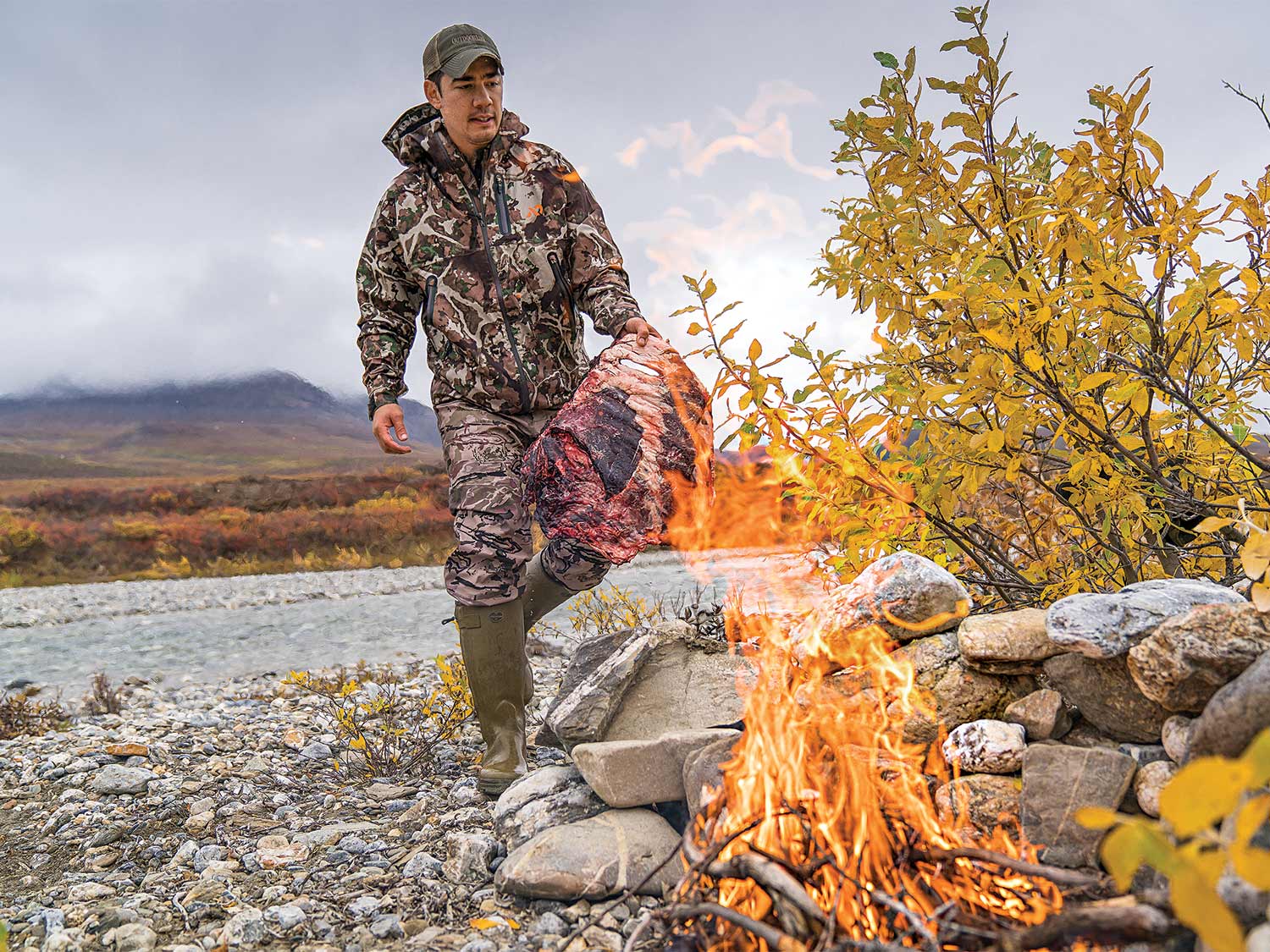
Questions Answered
On a normal day, Hansen is jovial but also overcome with an anxious wonder about the past, the present, and the immediate future. He asked our bush pilot dozens of questions, and the pilot’s gruff, short answers only encouraged him to ask a dozen more. Now with two bulls on the ground and hours of quartering and packing ahead, Hansen works himself into a frenzy. How long will it take to quarter a bull? How many trips will it take to pack one out? How much does a hind quarter weigh?
Now I’m the one lobbying for us to slow down and take it all in.
We reach Hansen’s bull first. It has disproportionately wide hooves that allow it to tromp across the muskeg. I run my hand across the bull’s back and feel his soft, fine hair, which reminds me of a yearling doe I once killed in Upstate New York. The bull’s antlers are even more impressive up close. If you were to take just one of the tops and mold it into a whitetail’s rack, it would outscore any buck I’ve ever seen in New England.
We gut Hansen’s bull and then hike up to mine. I’m thankful for another chance to inspect a caribou up close before turning the animal into meat. We marvel over his antlers for a bit, take some photos, and then go to work.
On our first pack trip, we find Rousey and Draper at camp. “Glad you guys made it in safely. Grab your packs and some water.” And back up the mountain we hike. With the five of us cutting and hauling, the job goes much faster. But still we don’t stagger in to camp with the last loads of meat till after midnight. By the time we get the quarters hung on the far side of the river, even Hansen is quiet.
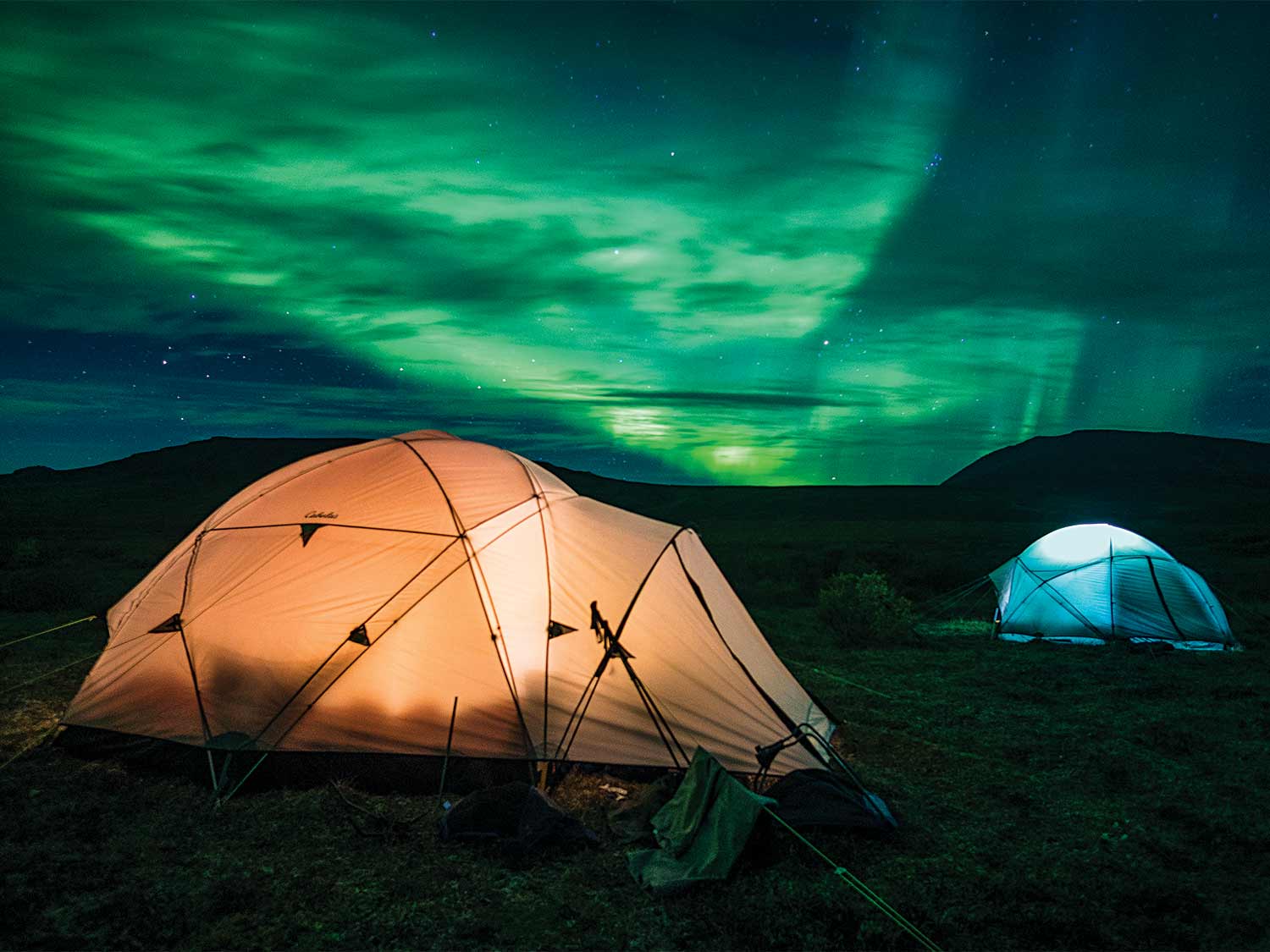
Last Lights
The next several days all meld together. Whipple and I spend one afternoon smoking a slab of caribou ribs over a willow-brush fire we make on the gravel bar. We build a makeshift grill out of river stones and gather a heaping pile of brush, playing like children and then feasting like kings.
Eventually, Rousey and Draper kill bulls, and we gladly repay the favor and help with their quartering and packing.
On the last afternoon, Hansen spots a lone grizzly a mile above camp. We watch it slowly head in our direction down a drainage.
Whipple, an Alaska resident, has a bear tag for the unit, so I give him my rifle and a handful of .300 Win. Mag. shells, and we make a run up toward the bear. Whipple had played his role as the easygoing cameraman the whole trip, but now he gets deadly serious. He kneels in the willows to say a quiet prayer, and then we creep within 200 yards of a patch of wavering brush. We can’t actually see the bear yet, so we push closer.
Whipple slips around one more patch of head-high brush, then spots the grizzly.
“Sticks,” Whipple says, and I shove the shooting sticks into his hand. The bear is turning to look at us, not quite threatening, but not spooked either.
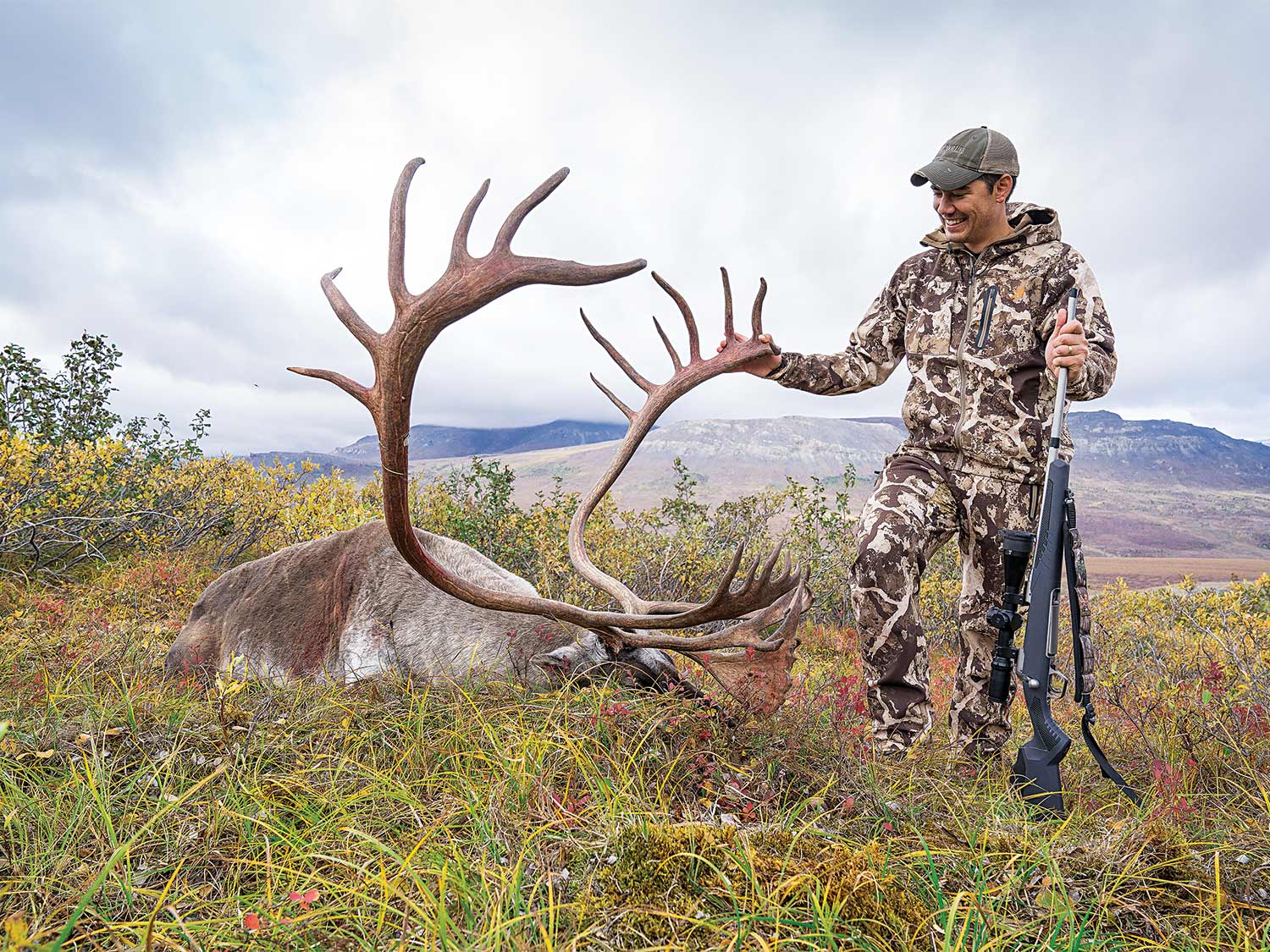
“Range?” he asks.
“Inside 100,” I say with a death grip on my rangefinder.
Whipple’s shot anchors the bear, and begins the last skinning and packing job of our adventure.
That night, we gather all the remaining whiskey in camp and stay up to watch the northern lights. Around 1 a.m. a green glow appears on the northern horizon. That glow morphs into a dancing ray of green light that eventually stretches across the entire sky. We stare up into the night until our necks ache, and hoot and holler like we’re worshiping some ancient spirit we’ve never known.
The Inuit people had different answers for what these magical green lights might be. Some believed they were spirits of their ancestors playing a game with a walrus skull. Another tribe believed they were walrus spirits playing a game with a human skull. My favorite, however, is that the lights are the spirits of animals that arctic hunters have killed.
An astronomer would explain that the aurora borealis actually occurs when electrically charged particles are thrown off the sun’s atmosphere and collide with gases in Earth’s atmosphere.
But Parrett, the caribou researcher, has had it right all along. Some things don’t need to be explained.
DIY Caribou Camp Essentials
We hired Ram Aviation to transport us to our caribou camp. The company charges $4,000 per hunter if you use its gear, but you can do the trip for less if you bring your own. We were allowed 60 pounds per person, which is a luxurious amount of weight for a hunt like this. So we put a premium on comfort and cooking. Here are some of our key camp items.
Ready Lite Low Chair
Weighs 2 pounds 6 ounces and provides a comfortable seat for glassing from camp (and drinking whiskey after the hunt). $90
Cabela’s Alaskan Guide Tent
Features a useful vestibule for stowing gear out of the rain and is designed to withstand the brutal tundra winds. $350
Camp Chef Sherpa Table
Organizes all of your cooking gear and provides a sturdy base for cutting boards and camp stoves. $146
Klymit Insulated Static V Sleeping Pad
Inflates quickly and keeps you off the cold muskeg and hard rocks. $85
Camp Chef Stryker 200 Multi-Fuel Stove
Runs on propane or isobutane (propane is much easier to buy in Kotzebue) and solves all your water-heating needs. $125

